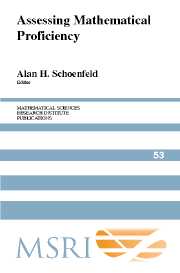Book contents
- Frontmatter
- Contents
- Preface
- Acknowledgments
- Section 1 The Big Picture
- Section 2 Perspectives on Mathematical Proficiency
- Section 3 What Does Assessment Assess? Issues and Examples
- 6 Mathematical Proficiency: What Is Important? How Can It Be Measured?
- 7 Aspects of the Art of Assessment Design
- 8 Mathematical Proficiency for Citizenship
- 9 Learning from Assessment
- 10 When Assessment Guides Instruction: Silicon Valley's Mathematics Assessment Collaborative
- Section 4 The Case of Algebra
- Section 5 What Do Assessments Assess? The Case of Fractions
- Section 6 The Importance of Societal Context
- Epilogue: What Do We Need to Know? Items for a Research Agenda
- About the Authors
- Subject Index
- Author Index
- Task Index
7 - Aspects of the Art of Assessment Design
Published online by Cambridge University Press: 06 July 2010
- Frontmatter
- Contents
- Preface
- Acknowledgments
- Section 1 The Big Picture
- Section 2 Perspectives on Mathematical Proficiency
- Section 3 What Does Assessment Assess? Issues and Examples
- 6 Mathematical Proficiency: What Is Important? How Can It Be Measured?
- 7 Aspects of the Art of Assessment Design
- 8 Mathematical Proficiency for Citizenship
- 9 Learning from Assessment
- 10 When Assessment Guides Instruction: Silicon Valley's Mathematics Assessment Collaborative
- Section 4 The Case of Algebra
- Section 5 What Do Assessments Assess? The Case of Fractions
- Section 6 The Importance of Societal Context
- Epilogue: What Do We Need to Know? Items for a Research Agenda
- About the Authors
- Subject Index
- Author Index
- Task Index
Summary
Educational design in general is a largely underestimated and unexplored area of design, and its relationship with educational research can be characterized as somewhat less than satisfying. The design of assessments is often seen as an afterthought. And it shows.
Of course, there is a wealth of publications on assessment, but quite often these focus on psychometric concerns or preparation for high-stakes tests (a very profitable industry). What is lacking is a tight linkage between research findings and the creation of mathematically rich and revealing tasks for productive classroom use. The report “Inside the black box” [Black and Wiliam 1998], which looks in depth at current research, shows clearly that we should not only invest more in classroom assessment in mathematics, but also that the rewards will be high if we do so.
Linking Items with Framework
To provoke some discussion, and to invite the reader to reflect on the items and make a judgment, I start the examples with an item from the Third International Mathematics and Science Study (TIMSS). According to the TIMSS web site http://www.timss.org, TIMSS was “the largest and most ambitious international study of student achievement ever conducted. In 1994–95, it was conducted at five grade levels in more than 40 countries (the third, fourth, seventh, and eighth grades, and the final year of secondary school).” Mathematics coverage on TIMSS was, in essence, international consensus coverage of the traditional curriculum.
- Type
- Chapter
- Information
- Assessing Mathematical Proficiency , pp. 99 - 112Publisher: Cambridge University PressPrint publication year: 2007



